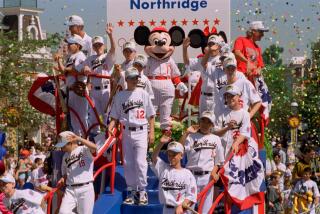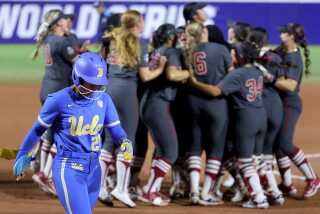No Runs, 1 Hit and a Horror : Humility Pops Up in Challenge of Cagey Softball Pitchers
- Share via
I’m batting .167 against Cal State Northridge softball pitchers this year, which is pretty impressive considering their other opponents have an average of .152.
I managed to lay some aluminum into what I think was a fastball, sending it to the outfield for a hit during an informal challenge match at the Northridge softball diamond the other day.
OK, so maybe the hit did just barely make it to the outfield grass. And so what if it blooped in just a few feet inside the right-field line? A “Dominguez Hills single,” as the blatantly biased players in the dugout so scornfully referred to it, is better than none at all.
Woefully few people thought this 26-year-old former high school baseball player would muster even that--among them, family members, alleged friends and Northridge Coach Gary Torgeson, who bit his lip to keep from breaking into laughter when I approached him with my plan. “Sure, I think it’s a great idea,” he said as tears welled up in his eyes.
Northridge, the top-ranked team in Division II, has four pitchers, all with ERAs less than 0.64. I took four at-bats against junior Delanee Anderson and three against freshman Debbie Dickman. The other two pitchers--Lisa Martin and Tracey Fox--were obviously ducking the contest. Martin (10-1, 0.45 ERA) didn’t even show up for practice. Fox (7-0, 0.27) had slammed her finger in the door of her dormitory room a few days before--purposely, no doubt, when she first heard of my challenge--and refused to pitch with a splint on her pitching hand.
Anderson, a junior who has a 46-10 record in three seasons, pitched first. According to my scouting report, which was provided by Fox as she fed a few balls into a pitching machine to help me warm up, Anderson had an above-average fastball but was better known for a nasty drop pitch.
Whoosh! Strike one. I hoped that was her fastball.
No, said catcher Reggie Lyons, smiling through her mask, that was a drop.
The next pitch I couldn’t positively identify, either, but it sounded inside as it buzzed under my chin. Lyons called it a strike and since I had closed my eyes as I bailed out, I couldn’t argue.
Pitch No. 3 I actually made contact with. The possibility of striking out every time had been eliminated. Such relief over an infield pop up.
The day’s final totals were one looping base hit, a strikeout, three pop ups and two ground outs. Could I make the club? Jamie Gray, an assistant coach who witnessed my, uh, display, looked a little skeptical. Considering I hadn’t hit one pitch sharply, or even to the left side of the infield, her pessimism was justified.
The best softball pitchers throw in the 65 to 70-m.p.h. range, which is relatively slow compared to, say, a fastball thrown at 90 m.p.h. by Jeremy Hernandez of the CSUN baseball team.
But I think I’d rather bat against him.
At least Hernandez throws straight overhand and the ball can be seen coming off his hand. Both Anderson and Dickman wore white shorts and the pitches looked as if they were coming out of their pant legs. And from only 43 feet away.
Secondly, hitting a softball is nothing like hitting a baseball. Softballs are, well, soft. Making contact with a drop pitch--which seems not only to sink, but also to break slightly away from a right-handed hitter--feels much like connecting with a 10-pound slab of Silly Putty. No ping or zing. Splat.
It was an educational experience to be sure. But if I ever try it again, I’ll be sure to use some advice I once heard given over the radio by that feared major league slugger Don Sutton.
Sutton, a pitcher, had just won a game for the Dodgers, but he was more interested in talking about a home run he had hit. When asked what kind of pitch he hit, he said he didn’t know. “I think I had my eyes closed,” he said. “I always figured if I kept swinging in the same place every time, they’d eventually hit my bat.”
Amen.
More to Read
Get our high school sports newsletter
Prep Rally is devoted to the SoCal high school sports experience, bringing you scores, stories and a behind-the-scenes look at what makes prep sports so popular.
You may occasionally receive promotional content from the Los Angeles Times.







